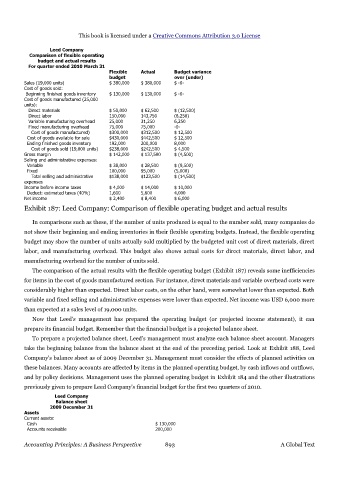Page 892 - Accounting Principles (A Business Perspective)
P. 892
This book is licensed under a Creative Commons Attribution 3.0 License
Leed Company
Comparison of flexible operating
budget and actual results
For quarter ended 2010 March 31
Flexible Actual Budget variance
budget over (under)
Sales (19,000 units) $ 380,000 $ 380,000 $ -0-
Cost of goods sold:
Beginning finished goods inventory $ 130,000 $ 130,000 $ -0-
Cost of goods manufactured (25,000
units):
Direct materials $ 50,000 $ 62,500 $ (12,500)
Direct labor 150,000 143,750 (6,250)
Variable manufacturing overhead 25,000 31,250 6,250
Fixed manufacturing overhead 75,000 75,000 -0-
Cost of goods manufactured) $300,000 $312,500 $ 12,500
Cost of goods available for sale $430,000 $442,500 $ 12,500
Ending finished goods inventory 192,000 200,000 8,000
Cost of goods sold (19,000 units) $238,000 $242,500 $ 4,500
Gross margin $ 142,000 $ 137,500 $ (4,500)
Selling and administrative expenses:
Variable $ 38,000 $ 28,500 $ (9,500)
Fixed 100,000 95,000 (5,000)
Total selling and administrative $138,000 $123,500 $ (14,500)
expenses
Income before income taxes $ 4,000 $ 14,000 $ 10,000
Deduct: estimated taxes (40%) 1,600 5,600 4,000
Net income $ 2,400 $ 8,400 $ 6,000
Exhibit 187: Leed Company: Comparison of flexible operating budget and actual results
In comparisons such as these, if the number of units produced is equal to the number sold, many companies do
not show their beginning and ending inventories in their flexible operating budgets. Instead, the flexible operating
budget may show the number of units actually sold multiplied by the budgeted unit cost of direct materials, direct
labor, and manufacturing overhead. This budget also shows actual costs for direct materials, direct labor, and
manufacturing overhead for the number of units sold.
The comparison of the actual results with the flexible operating budget (Exhibit 187) reveals some inefficiencies
for items in the cost of goods manufactured section. For instance, direct materials and variable overhead costs were
considerably higher than expected. Direct labor costs, on the other hand, were somewhat lower than expected. Both
variable and fixed selling and administrative expenses were lower than expected. Net income was USD 6,000 more
than expected at a sales level of 19,000 units.
Now that Leed's management has prepared the operating budget (or projected income statement), it can
prepare its financial budget. Remember that the financial budget is a projected balance sheet.
To prepare a projected balance sheet, Leed's management must analyze each balance sheet account. Managers
take the beginning balance from the balance sheet at the end of the preceding period. Look at Exhibit 188, Leed
Company's balance sheet as of 2009 December 31. Management must consider the effects of planned activities on
these balances. Many accounts are affected by items in the planned operating budget, by cash inflows and outflows,
and by policy decisions. Management uses the planned operating budget in Exhibit 184 and the other illustrations
previously given to prepare Leed Company's financial budget for the first two quarters of 2010.
Leed Company
Balance sheet
2009 December 31
Assets
Current assets:
Cash $ 130,000
Accounts receivable 200,000
Accounting Principles: A Business Perspective 893 A Global Text

